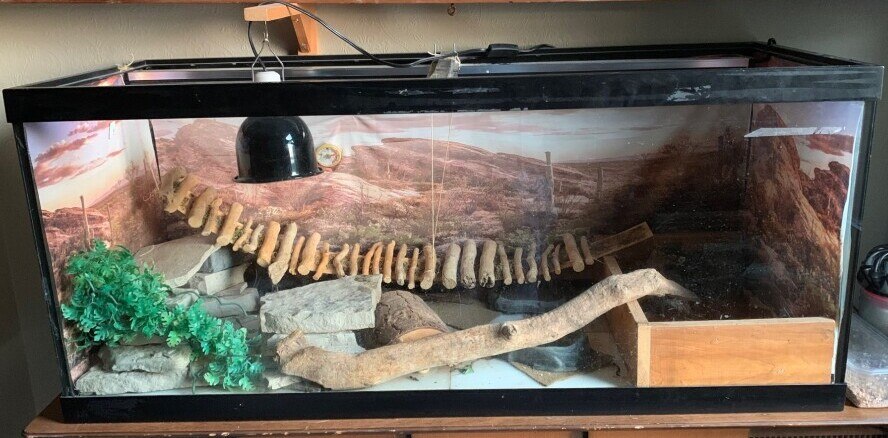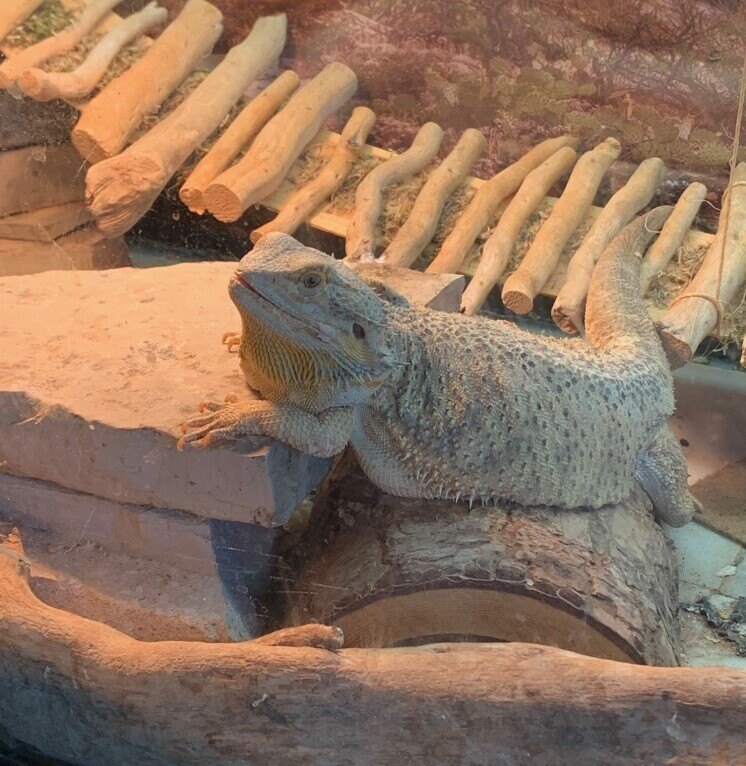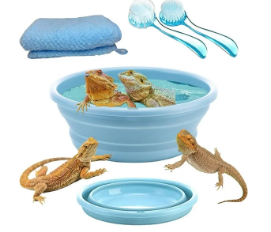This post contains affiliate links, which means I may earn money from products and services you purchase through my links.
Choosing a first pet is an exciting but important decision for those new to pet ownership. While dogs and cats come to mind, there is a unique and growing popular alternative you may not have considered: the bearded dragon. These intriguing reptiles are simple to care for and make friendly and engaging companions.

Bandit the Bearded Dragon
In this post, we’ll look at why a bearded dragon can be the ideal pet for you, including information on their maintenance, temperament, and the numerous advantages they provide to children and adults.
Introduction to Bearded Dragons
Bearded dragons, or “beardies,” are small to medium-sized reptiles native to Australia. They are popular pets due to their gentle demeanour and low maintenance requirements.
Whether you’re getting a bearded dragon as your first pet or want to learn more about these fascinating creatures, they are a popular choice. Discovering what makes them special is the first step toward a fulfilling pet ownership experience.
Why Are Bearded Dragons Popular as Pets?
Bearded dragons have grown popular among pet owners for several convincing reasons.
- Bearded dragons are naturally gentle, resilient, and easy to care for, making them perfect for children and beginners.
- Their small size, measuring 18-24 inches including their tails, makes them ideal for apartment residents or those with limited living space.
- Easy to maintain, they require a simple diet of insects, vegetables, and fruits. Bearded dragons are easy to enjoy because they don’t need daily walks, grooming, or frequent cleaning.
- Bearded dragons are known for their curiosity and energetic nature. They often explore their surroundings, bask under heat lamps, and interact with their owners.
- Bearded dragons, with a lifespan of 10-15 years, are a long-term, manageable pet that offers a balance of longevity and family companionship.
Bearded Dragon vs. Other Common First Pets
Due to their unique characteristics, bearded dragons stand out from popular pets like cats, dogs, hamsters, and fish.
Unlike dogs and cats, bearded dragons require less attention and exercise. They offer a simple care routine that focuses on feeding and maintaining their habitat.
Hamsters and other small animals are easy first pets but are frail and less interactive due to their nocturnal nature. Bearded dragons are diurnal, which means they are awake during the day. This makes them more engaging companions.
Fish are popular starter pets, but they are not interactive. Also, aquarium maintenance is more complex and time-consuming than caring for a bearded dragon.
Easy Care and Maintenance
Caring for bearded dragons is easy. They require basic needs like habitat setting, feeding, and occasional cleaning.
Simple Habitat Requirements for a Bearded Dragon

Setting up a habitat for your bearded dragon is simple, requiring no special equipment or complicated procedures.
- A 40-gallon terrarium or vivarium is important for adult bearded dragons, providing plenty of space for exploration and relaxation. Smaller tanks can be used, but they will need more room to grow.
- They require proper lighting and heating for a healthy habitat. They are cold-blooded and need external heat sources to regulate their body temperature, between 95°F and 110°F during the day. The cooler half of the tank should be between 75°F and 85°F for nighttime. UVB lighting provides vitamin D3, which is needed for overall health.
- Tank substrate (the material that lines the bottom of the tank) can be reptile carpet, tile, or paper towels, which is necessary for easy cleaning and safety. Loose materials like sand or wood chips should be avoided, especially for young dragons who might ingest them.
- Include rocks, branches, and hiding areas where they can climb, bask, and retreat when they want privacy. This encourages their natural behaviour while pleasantly enhancing their surroundings,

You can provide a comfortable and healthy environment with the perfect tank size, proper heating and lighting, safe substrate, and smart decor.
Feeding a Bearded Dragon for a Beard
Feeding a bearded dragon is one of the most enjoyable aspects of their maintenance because they have a diverse diet that is simple to maintain. Bearded dragons are omnivores; they consume both plant and animal foods. To ensure they obtain enough nutrients, they should eat a variety of insects, vegetables, and fruits.
Insects: Crickets, mealworms, and dubia roaches are common protein sources. Insects should be gut-loaded (fed nutritious food) before serving. Young dragons should be fed daily as they require more protein.
Vegetables: Leafy greens like collard, mustard, and dandelion greens are ideal for their plant-based diet, while carrots, squash, and bell peppers can be finely chopped or shredded. Avoid spinach and lettuce as they can be harmful and provide little nutrition.
Fruits: Fruits, such as berries, apples, and melons, should be served in bite-sized pieces, as they contain more sugar, and should be given sparingly.
Calcium: Calcium is necessary to prevent metabolic bone disease. Dust their food with calcium supplements weekly, and provide multivitamin supplements to fill nutritional gaps. Vitamin D3 is not required if they get enough UVB exposure.
Fresh water: Bearded dragons require fresh water in shallow dishes. Mist their vegetables before feeding to aid in hydration, as they absorb moisture from their food and surroundings.
Minimal Grooming Needs
One of the many benefits of owning a bearded dragon is that they require little grooming, making them an appealing option for first-time pet owners.
Shedding: They shed naturally while growing and less frequently as they age. To make shedding easier, provide a humid habitat with rough objects to rub against to remove loose skin. Occasionally spritz them with water.
Bathing: Bathing them is rarely necessary but occasionally can aid in hydration and shedding. It should be brief—10 to 15 minutes – lukewarm, and the water no deeper than their shoulders. Never leave them unattended.

Bearded dragons don’t require regular baths because of their dry, scaly skin which keeps them naturally dirt-free. By keeping their habitat clean, they will stay clean.
Nail trimming: Nails can grow longer in captivity, so occasionally they may need trimming. It’s important to gently cut their tips with reptile-safe clippers, avoiding cutting too close to the quick.
Friendly and Docile Nature
Bearded dragons are known for their friendly and calm personalities, making them a good choice for anybody new to pet ownership.
Ideal Temperament for Beginners
One of their main characteristics is their tolerance for handling, which allows them to be gently held from a young age. This helps them to become used to regular interaction, making them ideal for families with children.
Their disposition reduces stress-related health issues. As long as their basic needs are met, they will remain relaxed and healthy, making them enjoyable to care for.
Handling and Bonding with Your Bearded Dragon
Bearded dragons love to build ties with their owners. They may eventually know your voice and even show happiness as you approach them. This amount of contact is unusual in many reptiles and contributes to the appeal of owning a bearded dragon as a pet.
How Bearded Dragons Interact with Other Pets
Bearded dragons are gentle and adaptable pets, suitable for new owners or those seeking a stress-free, interactive companion. While they should be supervised, they can safely be introduced to other calm animals, making them an ideal choice when there are other pets
Educational Benefits for Children
Besides being fun and low-maintenance, bearded dragons offer educational opportunities for children, fostering responsibility and basic biological concepts. Owning a bearded dragon can provide educational benefits such as helping kids develop important skills and interests.
Teaching Responsibility through Pet Care
Teaching responsibility through pet care is one of the most important things a bearded dragon can teach children. Your child will gain valuable skills, including routine maintenance and time management.
Developing routine: They teach children the importance of routines, time management, and prioritization. This is accomplished through daily tasks like feeding, providing fresh water, and monitoring environmental conditions.
Understanding commitment: Caring for a bearded dragon teaches kids about commitment and long-term responsibility, as their actions directly impact their pet’s health and well-being and foster accountability.
Observing Unique Behaviors and Habits
Observing bearded dragons is a great way for children to learn about animal behaviour and instincts. These reptiles exhibit a variety of unique habits that can spark interest and provide educational insights.
Basking behaviour: These pets exhibit a unique basking behaviour. They will position themselves under a heat lamp to regulate their body temperature, an instinct that teaches children about thermoregulation in reptiles. This behaviour teaches children about how animals adjust their actions for health.
Beard display: Another interesting behaviour is their “beard” display. When threatened or trying to assert dominance, it will puff out its throat to create a beard-like appearance. This helps children learn about animal communication and body language.
Unique eating habits: Bearded dragons exhibit unique dietary habits, including methodical insect hunting and a taste for specific vegetables, providing information about their diet and feeding methods.
Encouraging Interest in Reptiles and Nature
Bearded dragons foster interest in reptiles and nature, providing children with opportunities to learn about habitat, nutrition, and life cycle. This can lead to a greater interest in herpetology, the study of reptiles and amphibians.
Interacting with your pet encourages a sense of awe about nature. Observing their interactions with their surroundings, from basking to seeking food, can encourage children to learn more about wildlife and ecosystems. This hands-on approach typically sparks an interest in nature protection and biology.
Long-Term Commitment and Considerations
Owning a bearded dragon is a rewarding experience but requires a long-term commitment. Understanding pet care responsibilities is necessary for maintaining health and happiness; this will help build a successful and fulfilling relationship with your pet.
Lifespan of a Bearded Dragon
Bearded dragons live an average of 10 to 15 years, depending on their care and overall health. Because of their long lives, this will be a long-time commitment.
A well-maintained habitat, a balanced diet, and regular veterinarian treatment can help them live a long and healthy life. Providing the correct atmosphere and supporting their dietary demands helps them live longer and improves their quality of life as they age.
Health and Veterinary Care
Health and veterinarian care is important to ensure your bearded dragon flourishes throughout its life. Regular check-ups with a reptile-savvy veterinarian will help detect any health problems early and keep your dragon in peak shape.
Routine exams: Regular examinations and fecal tests are necessary to detect common health issues like metabolic bone disease, linked to a lack of UVB lighting or insufficient calcium. It is also important to check for parasites.
Clean environment: Providing a clean and well-maintained habitat improves your dragon’s general health and lowers the danger of infection. To avoid health problems, maintain adequate temperatures and humidity levels, and provide a balanced diet.
What to Expect as Your Bearded Dragon Grows
As your bearded dragon grows, various changes and adjustments will be required to maintain their health and well-being.
Growth and Size: Bearded dragons rapidly grow in their first year, necessitating a larger tank with a capacity of around 40 gallons for their maximum size of 18-24 inches.
Dietary Needs: Their needs change with age. Young ones require more insects for protein and adults prefer a vegetable-based diet. Adjust feeding schedules accordingly.
Behavioural Changes: As they age, they may become more settled and less active. Activity levels and bathing patterns may alter, so be prepared to adjust their habitat accordingly.
Health Monitoring: Regular health checkups become increasingly important as your bearded dragon ages. Older dragons are more vulnerable to conditions such as arthritis or obesity, so keep a close eye on their health and alter their treatment as necessary.
Conclusion
Bearded dragons are ideal first pets due to their low maintenance, interesting personalities, and educational benefits. They teach responsibility and knowledge about reptile behaviour, making them a valuable addition to families.
However, understanding their long-term commitment and healthcare requirements is important for a loving and healthy environment.
My husband and I are professional house sitters. So far, we have not sat for a bearded dragon but did sit for two small geckos, Charlie and Cody, who required little care.

We love to travel. For our trip to Mexico, we were able to save money by house sitting, which was something completely new to us. If this is something that interests you, then check out TrustedHousesitters or HouseSitMexico (be sure and use Code thetr6210d47b7cc90 for discount). We hope you visit often.